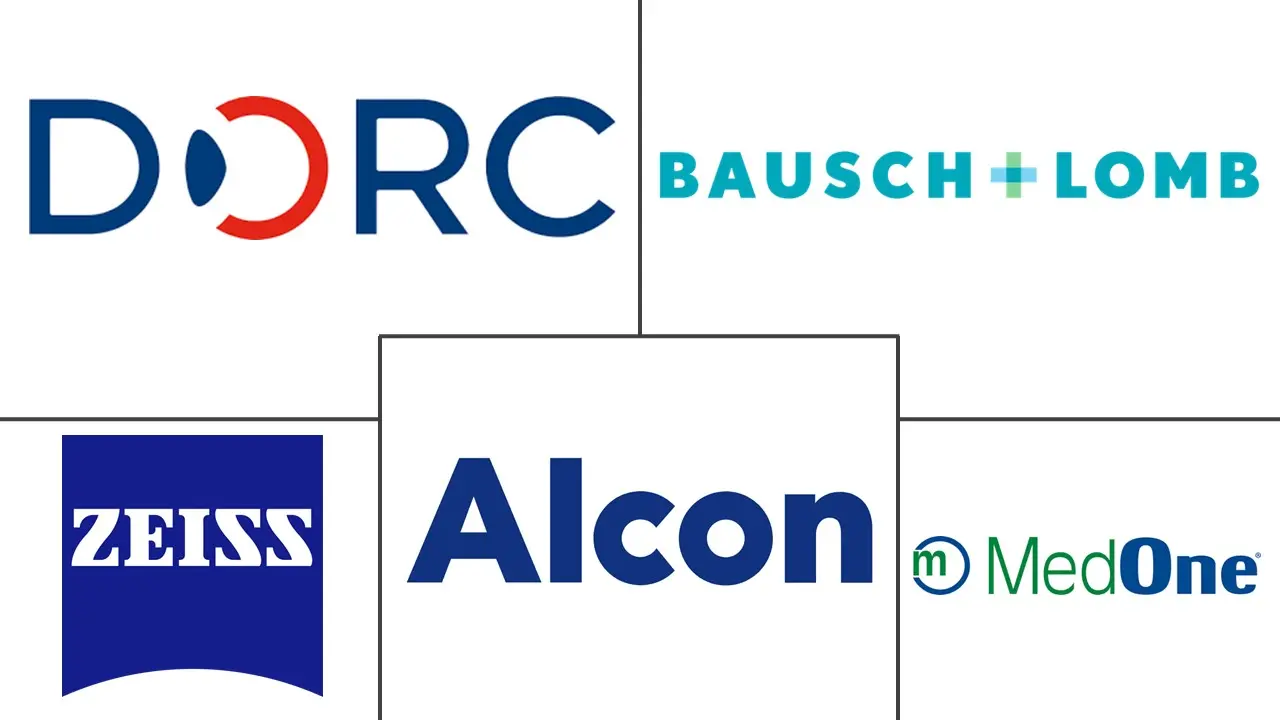Vitreoretinal Surgery Devices Market Size and Share
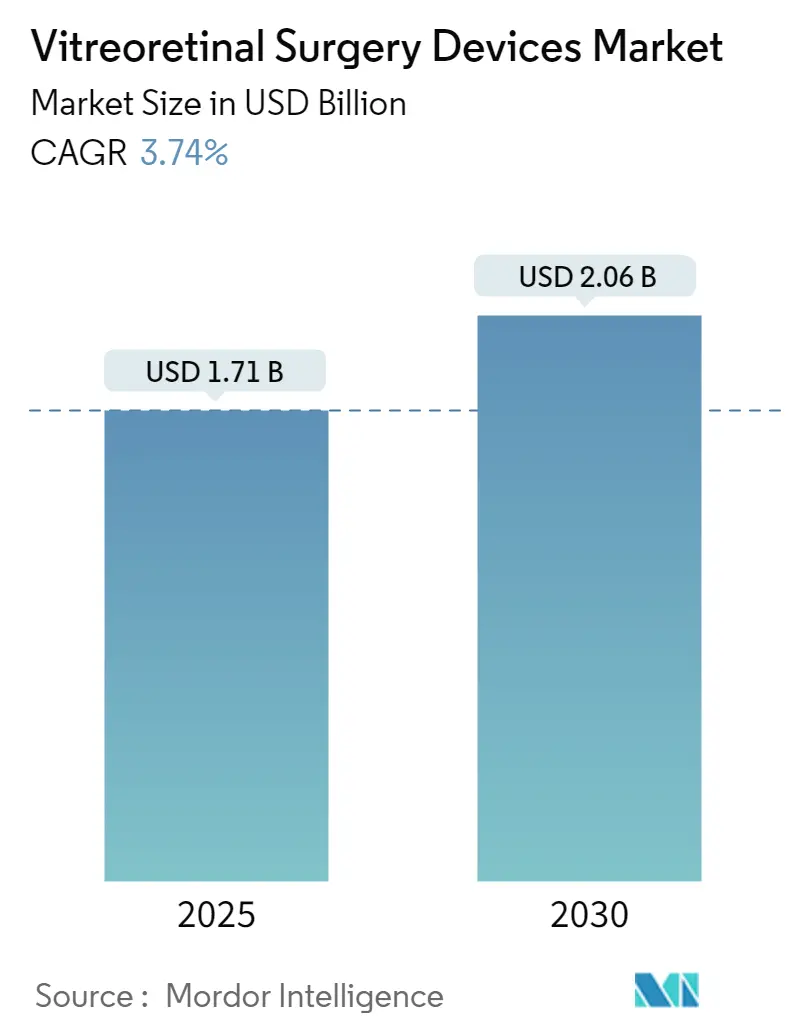
Vitreoretinal Surgery Devices Market Analysis by Mordor Intelligence
The Vitreoretinal Surgery Devices Market size is estimated at USD 1.71 billion in 2025, and is expected to reach USD 2.06 billion by 2030, at a CAGR of 3.74% during the forecast period (2025-2030).
The vitreoretinal surgery devices market is experiencing significant technological transformation, driven by innovations in surgical techniques and visualization technologies. Advanced robotic systems have emerged in four key categories: handheld instruments with intrinsic robotic assistance, hand-on-hand robotic systems, teleoperated robotic systems, and magnetic guidance robots. These developments are revolutionizing surgical precision and outcomes, with companies like Ophthorobotics AG introducing fully automated systems for intravitreal injections that incorporate specialized sensors and remote control capabilities.
The market is witnessing a substantial shift toward minimally invasive procedures and enhanced visualization systems. Digital imaging advancements, exemplified by systems like Alcon's Ngenuity 3-D platform, are providing surgeons with superior image depth and magnification while maintaining wide field views and improved ergonomics for extended surgical procedures. These systems also offer the advantage of reduced retinal phototoxicity through regulated light intensity control, marking a significant advancement in patient safety and surgical efficiency.
Strategic industry collaborations and technological partnerships are reshaping the competitive landscape. In January 2023, Bausch + Lomb formed a strategic partnership with Munich Surgical Imaging (MSI) to combine MSI's visualization expertise with Bausch + Lomb's surgical capabilities in the vitreoretinal surgery devices market. This collaboration exemplifies the industry's move toward integrated solutions that enhance surgical outcomes through improved visualization and precision.
The industry is experiencing rapid advancement in diagnostic imaging and molecular medicine integration. Optical coherence tomography angiography (OCT-A) has emerged as a breakthrough technology, offering noninvasive methods for detailed anatomical and physiological imaging of retinal-choroidal vascular plexuses. This technology has enabled quantitative imaging of retinal and choroidal vasculature as separate tissues, leading to novel discoveries regarding the pathophysiology of macular choroidal neovascularization and advancing treatment approaches in the retinal surgery devices market.
Global Vitreoretinal Surgery Devices Market Trends and Insights
Increasing Incidence of Eye Disorders
The growing prevalence of eye disorders is emerging as a significant global health concern, creating an increasing demand for the vitreoretinal surgery devices market. According to the World Health Organization (WHO), approximately 2.2 billion people worldwide have vision impairment or blindness, with at least 1 billion cases being preventable. The spectrum of eye disorders driving this trend includes diabetic retinopathy (3 million cases), macular holes, retinal detachment, vitreous hemorrhage, and various eye infections. Particularly concerning is the rising incidence of diabetic retinopathy, which, according to the International Diabetes Federation (IDF), is expected to increase significantly as the global diabetic population is projected to rise from 537 million in 2021 to 643 million by 2030 and 783 million by 2045.
The increasing focus on early diagnosis and treatment of eye disorders is further highlighting the critical need for advanced the vitrectomy devices market. Studies have shown that macular holes affect approximately 8.69 eyes per 100,000 people annually, typically presenting in patients older than 60 years and more commonly affecting women than men. Additionally, while 6% of the general population is estimated to have retinal breaks, the annual incidence of retinal detachment is approximately one in 10,000, or about 1 in 300 over a lifetime. These statistics underscore the growing burden of eye disorders and the subsequent need for sophisticated the retinal surgery devices market and procedures.
Increasing Geriatric Population
The global demographic shift towards an aging population is significantly influencing the demand for vitreoretinal surgery devices, as elderly individuals are more susceptible to various eye disorders. According to the World Health Organization's October 2021 update, by 2030, one in six people worldwide will be aged 60 years or above. This trend is expected to accelerate, with the global population of people aged 60 years and older projected to double by 2050, reaching approximately 2.1 billion. More significantly, the number of people aged 80 years or older is anticipated to triple between 2020 and 2050, reaching 426 million, creating a substantial patient pool requiring vitreoretinal interventions.
The correlation between aging and eye disorders is particularly evident in the increasing prevalence of age-related eye conditions requiring vitreoretinal surgery. For instance, research has demonstrated that age-related macular degeneration shows a strong correlation with advancing age, with a study published by BioMed Central Ltd in December 2021 revealing that among surveyed populations with age-related macular degeneration, 99.8% were in the age group of 61 years and above. This demographic shift is particularly pronounced in low- and middle-income countries, which are experiencing the greatest change in their population age structure. By 2050, two-thirds of the world's population over 60 years will reside in these regions, indicating a growing need for accessible and advanced vitreoretinal surgical solutions.
Segment Analysis: By Product Type
Vitrectomy Systems Segment in Vitreoretinal Surgery Devices Market
The vitrectomy devices market segment continues to dominate the global vitreoretinal surgery devices market, commanding approximately 50% of the total market share in 2024. This significant market position is attributed to the high utilization of these systems during surgical procedures and their proven effectiveness in treating various retinal conditions. The segment's dominance is further strengthened by continuous technological advancements in vitrectomy systems, including improved cutting speeds, enhanced fluidics control, and better visualization capabilities. Major market players like Alcon, Bausch & Lomb, and DORC have been instrumental in driving innovation in this segment through the introduction of advanced vitrectomy platforms that offer greater precision and improved surgical outcomes. Additionally, the growing adoption of minimally invasive vitreoretinal surgery techniques has further boosted the demand for sophisticated vitrectomy systems across healthcare facilities worldwide.
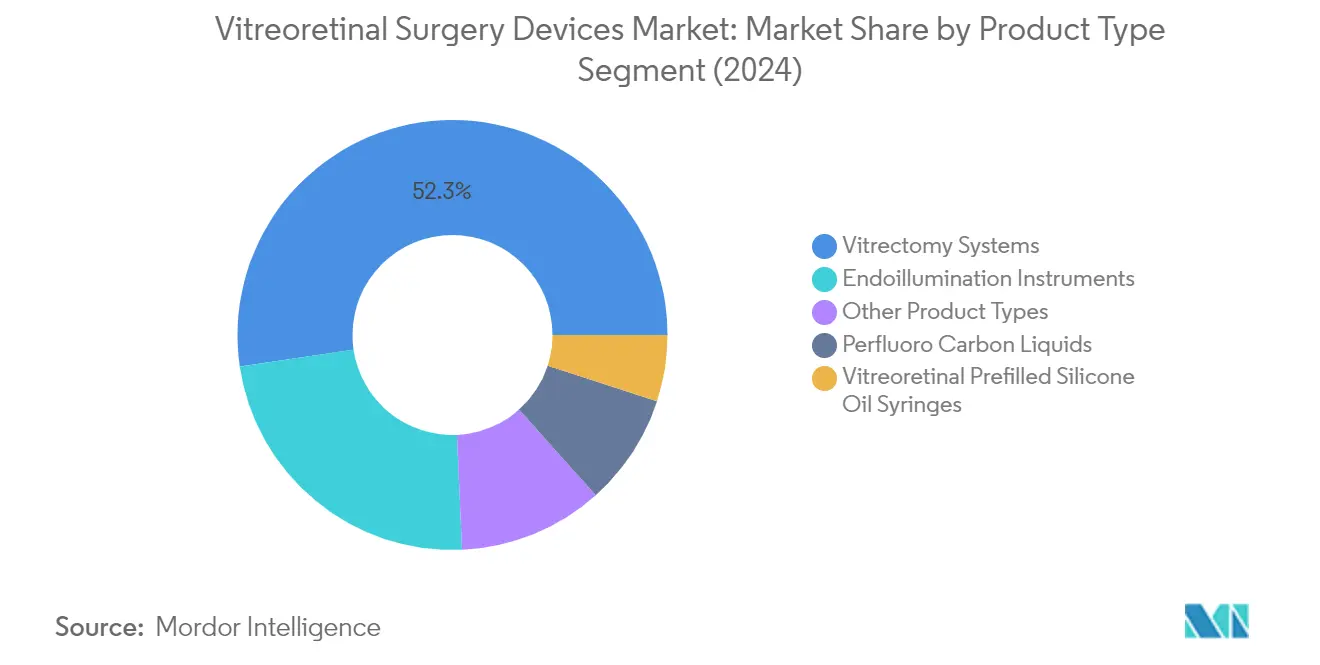
Growth Trajectory of Vitrectomy Systems in Vitreoretinal Surgery Devices Market
The vitrectomy devices market segment is projected to maintain its growth momentum, demonstrating the highest growth rate among all product segments with an estimated CAGR of approximately 4% from 2024 to 2029. This robust growth is driven by several factors, including the increasing prevalence of retinal disorders requiring surgical intervention, technological advancements in surgical techniques, and growing adoption of advanced vitrectomy systems in emerging markets. The segment's growth is further supported by the rising demand for minimally invasive surgical procedures, which has led to increased investment in research and development of more sophisticated vitrectomy systems. Healthcare facilities worldwide are increasingly upgrading their surgical capabilities with state-of-the-art vitrectomy systems, contributing to the segment's sustained growth trajectory.
Remaining Segments in Vitreoretinal Surgery Devices Market
The other significant segments in the vitreoretinal surgery devices market include Endoillumination Instruments, Perfluoro Carbon Liquids, and Vitreoretinal Prefilled Silicone Oil Syringes. Endoillumination Instruments play a crucial role in providing optimal visualization during surgical procedures, while Perfluoro Carbon Liquids are essential for complex retinal detachment surgeries. The vitreoretinal prefilled silicone oil syringe market offers convenience and precision in oil injection procedures. These segments collectively complement the vitrectomy systems, forming a comprehensive ecosystem of surgical tools and materials necessary for successful vitreoretinal procedures. The continued development of these supporting technologies and their essential role in various surgical applications ensures their steady presence in the market landscape.
Segment Analysis: By Surgery Type
Posterior Vitreoretinal Surgery Segment in Vitreoretinal Surgery Devices Market
The posterior vitreoretinal surgery segment dominates the vitreoretinal surgery devices market, commanding approximately 75% of the total market share in 2024. This substantial market leadership is primarily attributed to the high prevalence of posterior vitreoretinal diseases among the geriatric population globally. The segment's prominence is further reinforced by the increasing incidence of conditions such as diabetic retinopathy, endophthalmitis, and other posterior segment disorders that require surgical intervention. Additionally, technological advancements in posterior vitreoretinal surgical devices, including improved visualization systems and more precise surgical instruments, have contributed to the segment's market dominance. The segment is also experiencing the fastest growth trajectory in the market, with an expected growth rate of approximately 4% from 2024 to 2029, driven by the rising adoption of advanced surgical techniques and the growing burden of retinal disorders worldwide.
Anterior Vitreoretinal Surgery Segment in Vitreoretinal Surgery Devices Market
The anterior vitreoretinal surgery segment represents a crucial component of the vitreoretinal surgery devices market, focusing on treating conditions affecting the front part of the eye, including the iris, ciliary body, and anterior vitreous. This segment has established itself as an essential part of ophthalmic surgical procedures, particularly in addressing conditions like macular holes, epiretinal membranes, and anterior vitreous hemorrhage. The segment's growth is supported by continuous technological innovations in surgical instruments and techniques, enabling more precise and less invasive procedures. The development of specialized anterior segment surgical tools and improved visualization systems has enhanced surgical outcomes and patient recovery times. Furthermore, the increasing awareness about early diagnosis and treatment of anterior segment disorders, coupled with the growing accessibility to advanced surgical facilities, continues to drive the segment's expansion in the global market.
Vitreoretinal Surgery Devices Market Geography Segment Analysis
Vitreoretinal Surgery Devices Market in North America
North America represents a dominant force in the global vitreoretinal surgery devices market, driven by advanced healthcare infrastructure, high adoption of innovative medical technologies, and the presence of major market players. The region benefits from well-established reimbursement policies, an increasing prevalence of eye disorders, and a growing geriatric population across the United States, Canada, and Mexico. The sophisticated healthcare system, coupled with rising awareness about eye health and preventive care, has created a conducive environment for market growth in this region.
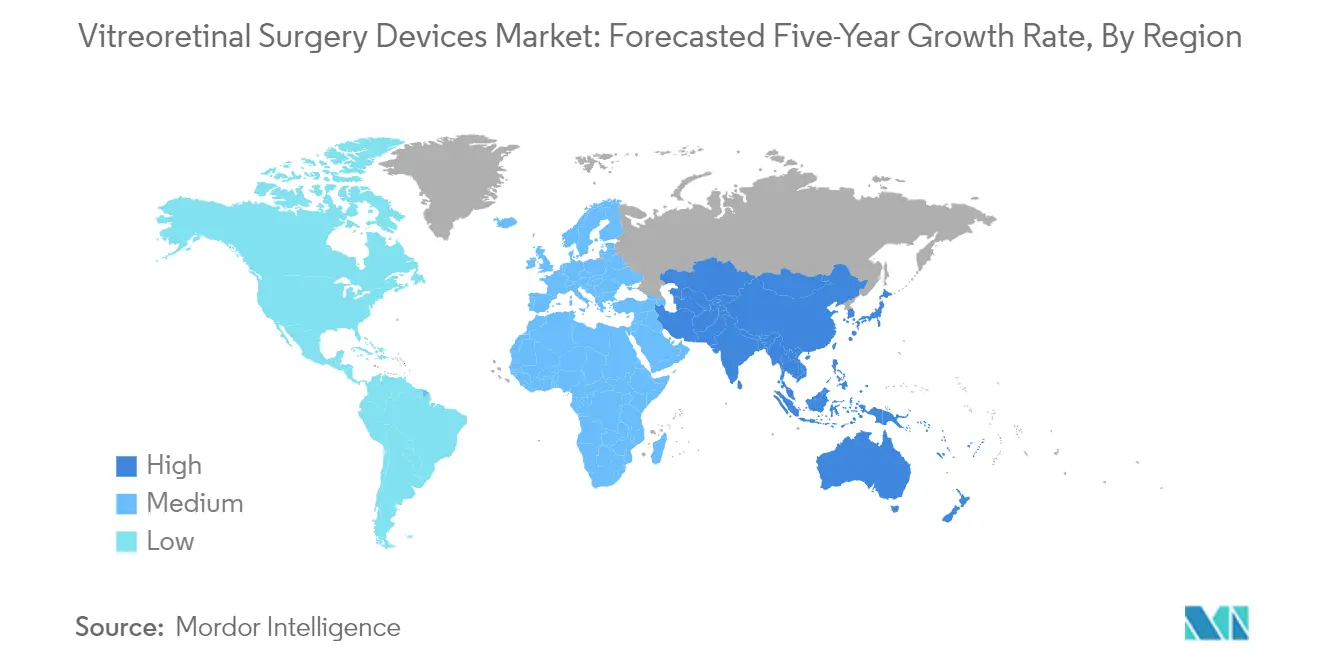
Vitreoretinal Surgery Devices Market in the United States
The United States maintains its position as the largest market for vitreoretinal surgery devices in North America, commanding approximately 83% of the regional market share in 2024. The country's market leadership is attributed to its extensive network of specialized eye care centers, high healthcare expenditure, and strong presence of key industry players. The rising incidence of diabetic retinopathy, macular holes, and retinal detachment among the aging population continues to drive market growth. Additionally, the country's robust research and development infrastructure, coupled with a favorable regulatory environment, has facilitated the introduction of advanced vitreoretinal surgical technologies.
Vitreoretinal Surgery Devices Market in Canada
Canada emerges as the fastest-growing market in North America, with a projected growth rate of approximately 5% during 2024-2029. The country's healthcare system emphasizes universal access to medical services, including advanced ophthalmic procedures. The growing adoption of innovative surgical techniques, increasing healthcare investments, and rising awareness about eye health contribute to market expansion. Furthermore, government initiatives to improve healthcare accessibility and the presence of skilled healthcare professionals have strengthened the market's growth trajectory in Canada.
Vitreoretinal Surgery Devices Market in Europe
Europe represents a significant market for vitreoretinal surgery devices, characterized by sophisticated healthcare systems, strong research capabilities, and an increasing focus on eye health across Germany, the United Kingdom, France, Italy, and Spain. The region's market is driven by technological advancements in surgical procedures, a growing elderly population, and a rising prevalence of eye disorders. The presence of established medical device manufacturers and continuous innovation in surgical techniques further strengthens the market landscape.
Vitreoretinal Surgery Devices Market in Germany
Germany stands as the largest market for vitreoretinal surgery devices in Europe, holding approximately 22% of the regional market share in 2024. The country's market dominance is supported by its advanced healthcare infrastructure, high healthcare spending, and strong emphasis on medical innovation. The presence of leading ophthalmology centers, coupled with increasing cases of age-related eye disorders, drives market growth. Germany's robust healthcare system and focus on adopting cutting-edge medical technologies continue to strengthen its position in the European market.
Vitreoretinal Surgery Devices Market in France
France demonstrates the highest growth potential in the European market, with an expected growth rate of approximately 5% during 2024-2029. The country's healthcare system prioritizes advanced medical treatments and maintains high standards in ophthalmic care. The increasing adoption of innovative surgical techniques, growing awareness about eye health, and rising investment in healthcare infrastructure contribute to market expansion. Additionally, France's strong focus on research and development in medical technologies supports the continuous evolution of vitreoretinal surgical procedures.
Vitreoretinal Surgery Devices Market in Asia-Pacific
The Asia-Pacific region represents a dynamic market for vitreoretinal surgery devices, encompassing diverse healthcare landscapes across China, Japan, India, Australia, and South Korea. The region experiences rapid market growth driven by improving healthcare infrastructure, increasing healthcare expenditure, and rising awareness about eye health. The large patient pool, coupled with growing access to advanced medical technologies, creates significant opportunities for market expansion.
Vitreoretinal Surgery Devices Market in Japan
Japan emerges as the largest market for vitreoretinal surgery devices in the Asia-Pacific region. The country's leadership position is attributed to its advanced healthcare system, high technological adoption rate, and significant elderly population. The presence of leading medical device manufacturers and a strong focus on healthcare innovation continues to drive market growth in Japan.
Vitreoretinal Surgery Devices Market in India
India demonstrates the highest growth potential in the Asia-Pacific region. The country's market expansion is driven by improving healthcare infrastructure, increasing healthcare accessibility, and rising awareness about eye health. The large patient population, growing medical tourism, and increasing adoption of advanced surgical techniques contribute to market growth. Additionally, government initiatives to enhance healthcare services and the presence of skilled healthcare professionals support market development.
Vitreoretinal Surgery Devices Market in the Middle East & Africa
The Middle East & Africa region presents a growing market for vitreoretinal surgery devices, with varying healthcare landscapes across GCC countries and South Africa. The market is characterized by improving healthcare infrastructure, increasing healthcare investments, and rising awareness about eye health. The GCC countries lead the regional market due to advanced healthcare facilities and high healthcare spending, while South Africa demonstrates the fastest growth potential driven by improving healthcare access and increasing adoption of advanced surgical techniques.
Vitreoretinal Surgery Devices Market in South America
South America exhibits significant potential in the vitreoretinal surgery devices market, with Brazil and Argentina as key contributing countries. The region's market growth is driven by improving healthcare infrastructure, increasing healthcare expenditure, and rising awareness about eye health. Brazil leads the regional market with advanced healthcare facilities and a strong presence of medical device manufacturers, while Argentina shows the fastest growth potential supported by improving healthcare access and adoption of innovative surgical techniques.
Competitive Landscape
Top Companies in Vitreoretinal Surgery Devices Market
The vitreoretinal surgery devices market is characterized by continuous product innovation and technological advancement from leading players like Alcon, Bausch & Lomb, Carl Zeiss, and Dutch Ophthalmic Research Center International (DORC). Companies are focusing on developing smaller, faster, and safer devices while incorporating robotic technologies and advanced visualization systems. Strategic partnerships and collaborations with healthcare providers and research institutions have become increasingly common to enhance product development and market reach. Market leaders are expanding their geographical presence through distributor networks and direct sales forces, particularly in emerging markets. The emphasis on post-sale support services and training programs has become a key differentiator, while investments in research and development continue to drive the introduction of next-generation surgical systems and instruments.
Consolidated Market Led By Global Players
The vitreoretinal surgery devices market exhibits a relatively consolidated structure dominated by large multinational medical device manufacturers with diverse product portfolios. These established players leverage their extensive manufacturing capabilities, robust distribution networks, and strong brand recognition to maintain their market positions. The market has seen a mix of both specialized ophthalmic device manufacturers and diversified healthcare conglomerates, with the latter bringing significant financial resources and cross-segment synergies to their operations. Regional players maintain their presence through a focus on specific product categories and strong local relationships with healthcare providers.
The industry has witnessed strategic mergers and acquisitions aimed at portfolio expansion and technological capability enhancement. Large companies have been actively acquiring innovative startups and smaller companies to access new technologies and expand their product offerings. Vertical integration strategies have been observed as companies seek to control key components of the supply chain and enhance operational efficiency. The market also sees collaborative arrangements between manufacturers and healthcare institutions for product development and clinical validation, contributing to market consolidation.
Innovation and Service Drive Market Success
Success in the DORC market increasingly depends on companies' ability to innovate while maintaining cost-effectiveness and regulatory compliance. Incumbent players are focusing on developing comprehensive product ecosystems that include both surgical devices and complementary technologies, while also strengthening their service and support infrastructure. The ability to provide comprehensive training programs and technical support has become crucial for market success. Companies are also investing in digital technologies and data analytics capabilities to enhance surgical outcomes and provide value-added services to healthcare providers.
Market contenders are finding opportunities through specialization in specific product categories and focusing on underserved market segments. The increasing emphasis on minimally invasive procedures and outpatient surgery creates opportunities for innovative solutions that improve surgical efficiency and patient outcomes. Regulatory compliance and quality assurance remain critical success factors, particularly as healthcare providers become more concentrated and demanding in their procurement processes. The risk of substitution remains relatively low due to the specialized nature of vitreoretinal surgery, but companies must continue to demonstrate clinical value and cost-effectiveness to maintain their market positions.
Vitreoretinal Surgery Devices Industry Leaders
-
Dutch Ophthalmic Research Center International BV
-
Bausch & Lomb, Inc
-
Alcon, Inc.
-
Carl Zeiss
-
MedOne Surgical, Inc
- *Disclaimer: Major Players sorted in no particular order
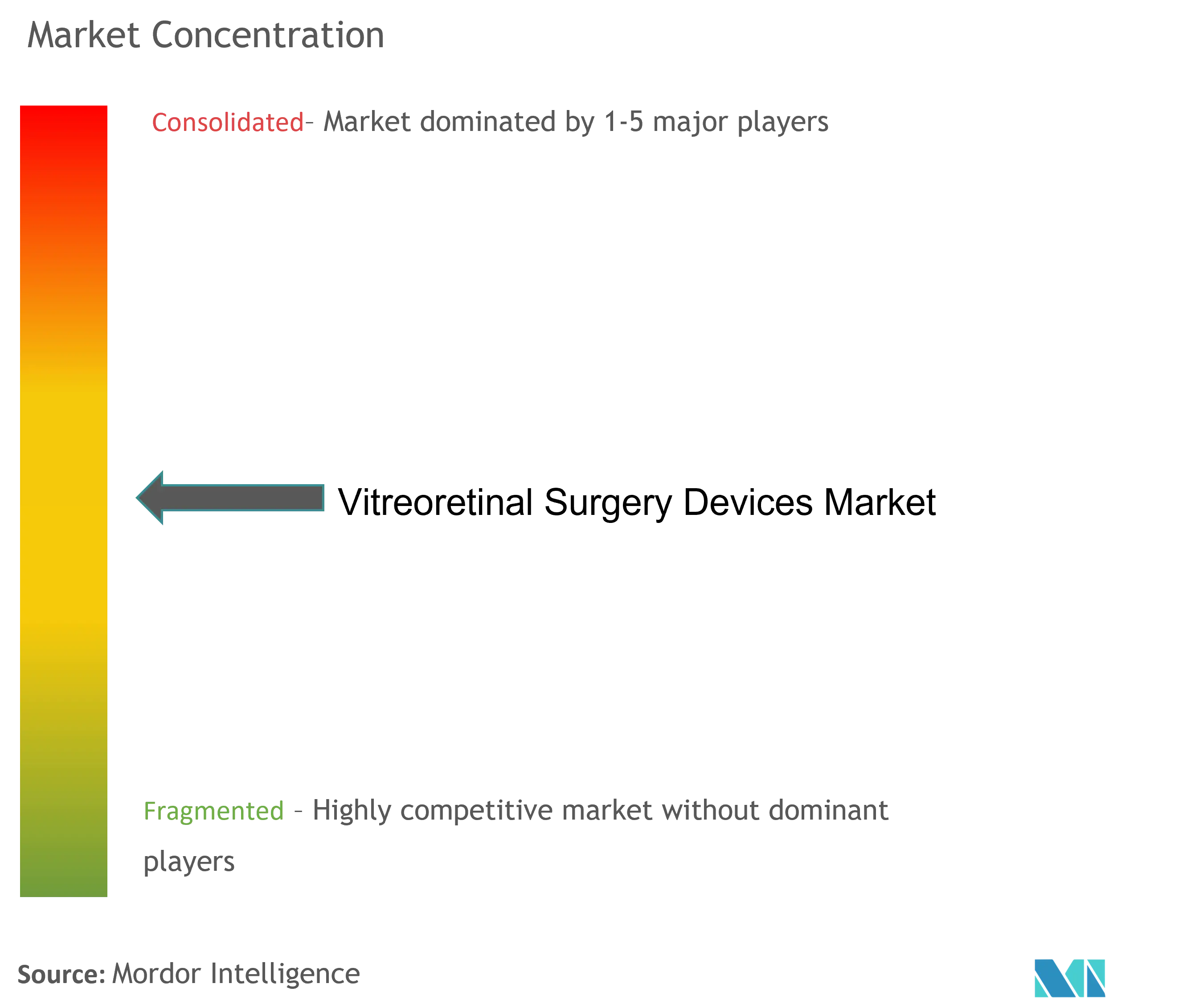
Recent Industry Developments
- July 2022: Moria, a France-based company, acquired AlchimiaSRL, an Italian-based company. AlchimiaSRL is a manufacturer of devices for ophthalmic surgery and human tissue banking. This acquisition is expected to complete Moria'sexisting range of products for vitreoretinal surgery and keratoplasty.
- May 2022: D.O.R.C. Dutch Ophthalmic Research Center (International) received 510(k) premarket approval from the United States Food and Drug Administration (FDA) for their EVA NEXUS Ophthalmic Surgical System. It is indicated for vitreoretinal ophthalmic surgery, including subretinal microinjection of gases or aqueous fluids.
Global Vitreoretinal Surgery Devices Market Report Scope
As per the scope of the report, vitreoretinal surgery devices are used to conduct surgeries for diseases like macular degeneration, retinal detachment, uveitis, vitreous hemorrhage, macular hole and epiretinal membrane, retinal detachment, and complications related to diabetic retinopathy. The Vitreoretinal Surgery Devices Market is segmented by Product Type (Perfluorocarbon Liquids, Endoillumination Instrument, Vitreoretinal Prefilled Silicone Oil Syringes, Vitrectomy System, and Other Product Types), Surgery Type (Anterior Vitreoretinal Surgery and Posterior Vitreoretinal Surgery), and Geography (North America, Europe, Asia-Pacific, Middle East and Africa, and South America). The market report also covers the estimated market sizes and trends for 17 countries across major regions globally. The report offers the value (in USD million) for the above segments.
| Perfluoro Carbon Liquids |
| Endoillumination Instruments |
| Vitreoretinal Prefilled Silicone Oil Syringes |
| Virectomy System |
| Other Product Types |
| Anterior Vitreoretinal Surgery |
| Posterior Vitreoretinal Surgery |
| North America | United States |
| Canada | |
| Mexico | |
| Europe | Germany |
| United Kingdom | |
| France | |
| Italy | |
| Spain | |
| Rest of Europe | |
| Asia-Pacific | China |
| Japan | |
| India | |
| Australia | |
| South Korea | |
| Rest of Asia-Pacific | |
| Middle East and Africa | GCC |
| South Africa | |
| Rest of Middle East and Africa | |
| South America | Brazil |
| Argentina | |
| Rest of South America |
| By Product Type | Perfluoro Carbon Liquids | |
| Endoillumination Instruments | ||
| Vitreoretinal Prefilled Silicone Oil Syringes | ||
| Virectomy System | ||
| Other Product Types | ||
| By Surgery Type | Anterior Vitreoretinal Surgery | |
| Posterior Vitreoretinal Surgery | ||
| Geography | North America | United States |
| Canada | ||
| Mexico | ||
| Europe | Germany | |
| United Kingdom | ||
| France | ||
| Italy | ||
| Spain | ||
| Rest of Europe | ||
| Asia-Pacific | China | |
| Japan | ||
| India | ||
| Australia | ||
| South Korea | ||
| Rest of Asia-Pacific | ||
| Middle East and Africa | GCC | |
| South Africa | ||
| Rest of Middle East and Africa | ||
| South America | Brazil | |
| Argentina | ||
| Rest of South America | ||
Key Questions Answered in the Report
How big is the Vitreoretinal Surgery Devices Market?
The Vitreoretinal Surgery Devices Market size is expected to reach USD 1.71 billion in 2025 and grow at a CAGR of 3.74% to reach USD 2.06 billion by 2030.
What is the current Vitreoretinal Surgery Devices Market size?
In 2025, the Vitreoretinal Surgery Devices Market size is expected to reach USD 1.71 billion.
Who are the key players in Vitreoretinal Surgery Devices Market?
Dutch Ophthalmic Research Center International BV, Bausch & Lomb, Inc, Alcon, Inc., Carl Zeiss and MedOne Surgical, Inc are the major companies operating in the Vitreoretinal Surgery Devices Market.
Which is the fastest growing region in Vitreoretinal Surgery Devices Market?
Asia Pacific is estimated to grow at the highest CAGR over the forecast period (2025-2030).
Which region has the biggest share in Vitreoretinal Surgery Devices Market?
In 2025, the North America accounts for the largest market share in Vitreoretinal Surgery Devices Market.
What years does this Vitreoretinal Surgery Devices Market cover, and what was the market size in 2024?
In 2024, the Vitreoretinal Surgery Devices Market size was estimated at USD 1.65 billion. The report covers the Vitreoretinal Surgery Devices Market historical market size for years: 2019, 2020, 2021, 2022, 2023 and 2024. The report also forecasts the Vitreoretinal Surgery Devices Market size for years: 2025, 2026, 2027, 2028, 2029 and 2030.
Page last updated on:
